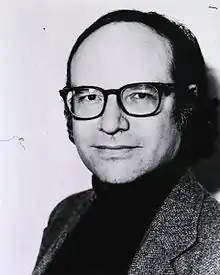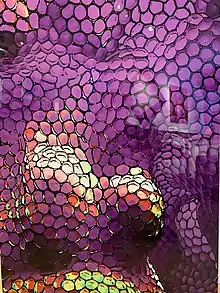Walter Gilbert | |
|---|---|
 Walter Gilbert in 2008 | |
| Born | March 21, 1932 Boston, Massachusetts, United States |
| Education |
|
| Known for | DNA sequencing |
| Spouse |
Celia Stone (m. 1953) |
| Children | 2[1] |
| Awards |
|
| Scientific career | |
| Fields | |
| Institutions | Harvard University |
| Thesis | On generalised dispersion relations and meson-nucleon scattering (1958) |
| Doctoral advisor | Abdus Salam |
| Doctoral students | |
| Website | www |
Walter Gilbert (born March 21, 1932) is an American biochemist, physicist, molecular biology pioneer, and Nobel laureate.[1][4][5]
Education and early life
Walter Gilbert was born in Boston, Massachusetts, on March 21, 1932, into a Jewish family,[6] the son of Emma (Cohen), a child psychologist, and Richard V. Gilbert, an economist.[4][7]
When Gilbert was seven years old, the family moved to the Washington D.C. area so his father could work under Harry Hopkins on the New Deal brain trust. While living in Washington the family became friends with the family of I.F. Stone and Wally met Stone's oldest daughter, Celia, when they were both 8. They later married at age 21.[8]
He was educated at the Sidwell Friends School, and attended Harvard University for undergraduate and graduate studies, earning a baccalaureate in chemistry and physics in 1953 and a master's degree in physics in 1954.[4] He studied for his doctorate at the University of Cambridge, where he earned a PhD in physics supervised by the Nobel laureate Abdus Salam in 1957.[4][9]
Career and research
Gilbert returned to Harvard in 1956 and was appointed assistant professor of physics in 1959.[4] Gilbert's wife Celia worked for James Watson, leading Gilbert to become interested in molecular biology. Watson and Gilbert ran their laboratory jointly through most of the 1960s, until Watson left for Cold Spring Harbor Laboratory.[10] In 1964 he was promoted to associate professor of biophysics and promoted again in 1968 to professor of biochemistry.[4]
Gilbert is a co-founder of the biotech start-up companies Biogen, with Kenneth Murray, Phillip Sharp and Charles Weissman[11] and Myriad Genetics with Dr. Mark Skolnick and Kevin Kimberlin[12][13] where he was the first chairman on their respective boards of directors. Gilbert left his position at Harvard to run Biogen as CEO, but was later asked to resign by the company's board of directors.[14] He is a member of the Board of Scientific Governors at The Scripps Research Institute. Gilbert has served as the chairman of the Harvard Society of Fellows.
In 1996, Gilbert and Stuart B. Levy founded Paratek Pharmaceuticals. Gilbert served as chairman until 2014.[15]
Gilbert was an early proponent of sequencing the human genome. At a March 1986 meeting in Santa Fe New Mexico he proclaimed "The total human sequence is the grail of human genetics". In 1987, he proposed starting a company called Genome Corporation to sequence the genome and sell access to the information.[14] In an opinion piece in Nature in 1991, he envisioned completion of the human genome sequence transforming biology into a field in which computer databases would be as essential as laboratory reagents[16]
Gilbert returned to Harvard in 1985.[17] Gilbert was an outspoken critic of David Baltimore in the handling of the scientific fraud accusations against Thereza Imanishi-Kari.[18] Gilbert also joined the early controversy over the cause of AIDS.[19] In 1962, Gilbert's PhD student in physics Gerald Guralnik extended Gilbert's work on massless particles; Guralnik's work on is widely recognized as an important thread in the discovery of the Higgs Boson.[20]
With his PhD student Benno Müller-Hill, Gilbert was the first to purify the lac repressor,[21] just beating out Mark Ptashne for purifying the first gene regulatory protein.[22]
Together with Allan Maxam, Gilbert developed a new DNA sequencing method, Maxam–Gilbert sequencing,[23][24] using chemical methods developed by Andrei Mirzabekov. His approach to the first synthesis of insulin via recombinant DNA[25] lost out to Genentech's approach which used genes built up from the nucleotides rather than from natural sources. Gilbert's effort was hampered by a temporary moratorium on recombinant DNA work in Cambridge, Massachusetts, forcing his group to move their work to an English biological weapons site.[26]
Gilbert first proposed the existence of introns and exons and explained the evolution of introns in a seminal 1978 "News and Views" paper published in Nature.[27] In 1986, Gilbert proposed the RNA world hypothesis for the origin of life,[28] based on a concept first proposed by Carl Woese in 1967.
Awards and honors

In 1969, Gilbert was awarded Harvard's Ledlie Prize.[4] In 1972 he was named American Cancer Society Professor of Molecular Biology.[4] In 1979, Gilbert was awarded the Louisa Gross Horwitz Prize from Columbia University together with Frederick Sanger.[4][29] That year he was also awarded the Gairdner Prize and the Albert Lasker Award for Basic Medical Research.[4]
Gilbert was awarded the 1980 Nobel Prize in Chemistry, shared with Frederick Sanger and Paul Berg. Gilbert and Sanger were recognized for their pioneering work in devising methods for determining the sequence of nucleotides in a nucleic acid.
Gilbert has also been honored by the National Academy of Sciences (US Steel Foundation Award, 1968); Massachusetts General Hospital (Warren Triennial Prize, 1977);[30] the New York Academy of Sciences; (Louis and Bert Freedman Foundation Award, 1977), the Académie des Sciences of France (Prix Charles-Leopold Mayer Award, 1977).[4] Gilbert was elected a Foreign Member of the Royal Society (ForMemRS) in 1987.[4][31][32]
In 2002, he received the Biotechnology Heritage Award, from the Biotechnology Industry Organization (BIO) and the Chemical Heritage Foundation.[33][34]
Allan Maxam and Walter Gilbert's 1977 paper "A new method for sequencing DNA" was honored by a Citation for Chemical Breakthrough Award from the Division of History of Chemistry of the American Chemical Society for 2017. It was presented to the Department of Molecular & Cellular Biology, Harvard University.[35][24]
Personal life
Gilbert married Celia Stone, the daughter of I. F. Stone, in 1953 and has two children.[1] After retiring from Harvard in 2001, Gilbert has launched an artistic career to combine art and science. His art format is centered on digital photography.[17][36]

See also
References
- 1 2 3 4 Walter Gilbert on Nobelprize.org , accessed 11 October 2020
- ↑ Church, G.; Gilbert, W. (1984). "Genomic sequencing". Proceedings of the National Academy of Sciences of the United States of America. 81 (7): 1991–1995. Bibcode:1984PNAS...81.1991C. doi:10.1073/pnas.81.7.1991. PMC 345422. PMID 6326095.
- ↑ "Jack Greenblatt". academictree.org.
- 1 2 3 4 5 6 7 8 9 10 11 12 Shampo MA, Kyle RA (May 2003). "Walter Gilbert--1980 Nobel Prize for Chemistry". Mayo Clin. Proc. 78 (5): 588. doi:10.4065/78.5.588. PMID 12744546.
- ↑ Walter Gilbert's publications indexed by the Scopus bibliographic database. (subscription required)
- ↑ JINFO. "Jewish Nobel Prize Winners in Chemistry". www.jinfo.org. Retrieved 2023-03-30.
- ↑ "Home - the Chicago Literary Club" (PDF).
- ↑ Saltzman, Jonathan (2018-03-31). "Five things you should know about Wally Gilbert". The Boston Globe. Retrieved 2018-04-01.
- ↑ Gilbert, Walter (1958). On generalised dispersion relations and meson-nucleon scattering (PhD thesis). University of Cambridge. OCLC 879396761.
- ↑ Watson, James D. (2003). Genes, Girls and Gamow.
- ↑ Stendahl, Max (May 31, 2018). "40 years later, Biogen's founders Get the Band Back Together". Boston Business Journal.
- ↑ Davies, Kevin; White, Michael (1996). Breakthrough: The Race to Find the Breast Cancer Gene. Wiley. p. 199.
- ↑ "MYRIAD: PIONEERING PREDICTIVE MEDICINE". University of Utah. April 25, 2018.
- 1 2 Kanigel, Robert (December 13, 1987). "The Genome Project". The New York Times Magazine: 44, 98–101, 106. PMID 11658922.
- ↑ "Founders".
- ↑ Gilbert, Walter (1991). "Towards a paradigm shift in biology". Nature. 349 (6305): 99. Bibcode:1991Natur.349...99G. doi:10.1038/349099a0. PMID 1986314. S2CID 1173431.
- 1 2 Johnson, Carolyn Y. (March 13, 2015). "A physicist, biologist, Nobel laureate, CEO, and now, artist". The Boston Globe.
- ↑ Kolata, Gina (June 25, 1996). "Inquiry lacking due process". The New York Times Books.
- ↑ Cohen, Jon (December 9, 1984). "The Duesberg Phenomenon" (PDF). Science. 266 (5191): 1643–1644. Bibcode:1994Sci...266.1642C. doi:10.1126/science.7992043. PMID 7992043.
- ↑ Close, Frank (2013). The Infinity Puzzle: The Personalities, Politics and Extraordinary Science Behind the Higgs Boson. Oxford University Press. pp. 146–147.
- ↑ Gilbert, Walter; Müller-Hill, Benno (December 1966). "Isolation of the lac repressor". PNAS. 56 (6): 1891–1898. Bibcode:1966PNAS...56.1891G. doi:10.1073/pnas.56.6.1891. PMC 220206. PMID 16591435.
- ↑ Ptashne, Mark (February 1967). "Isolation of the lambda phage repressor". PNAS. 57 (2): 306–313. Bibcode:1967PNAS...57..306P. doi:10.1073/pnas.57.2.306. PMC 335506. PMID 16591470.
- ↑ Maxam, Allan; Gilbert, Walter (1980). "Sequencing end-labeled DNA with base-specific chemical cleavages". Nucleic Acids Part I. Methods in Enzymology. Vol. 65. pp. 499–560. doi:10.1016/S0076-6879(80)65059-9. ISBN 9780121819651. PMID 6246368.
- 1 2 Maxam, A.; Gilbert, W. (1977). "A new method for sequencing DNA". Proceedings of the National Academy of Sciences of the United States of America. 74 (2): 560–564. Bibcode:1977PNAS...74..560M. doi:10.1073/pnas.74.2.560. PMC 392330. PMID 265521.
- ↑ Villa-Komaroff L, Efstratiadis A, Broome S, Lomedico P, Tizard R, Naber SP, Chick WL, Gilbert W (1978). "A bacterial clone synthesizing proinsulin". PNAS. 75 (8): 3727–31. Bibcode:1978PNAS...75.3727V. doi:10.1073/pnas.75.8.3727. PMC 392859. PMID 358198.
- ↑ Hall, Stephen S. (1987). Invisible Frontiers: The Race to Synthesize a Human Gene. Atlantic Monthly Press.
- ↑ Gilbert, Walter (February 9, 1978). "Why genes in pieces". Nature. 271 (5645): 501. Bibcode:1978Natur.271..501G. doi:10.1038/271501a0. PMID 622185. S2CID 4216649.
- ↑ Gilbert, W. (1986). "Origin of life: The RNA world". Nature. 319 (6055): 618. Bibcode:1986Natur.319..618G. doi:10.1038/319618a0. S2CID 8026658.
- ↑ Brownlee, George G. (2015). "Frederick Sanger CBE CH OM. 13 August 1918 — 19 November 2013". Biographical Memoirs of Fellows of the Royal Society. Royal Society publishing. 61: 437–466. doi:10.1098/rsbm.2015.0013. ISSN 0080-4606.
- ↑ "Warren Triennial Prize". ecor.mgh.harvard.edu. Archived from the original on November 27, 2020. Retrieved 2021-10-05.
- ↑ "Professor Walter Gilbert ForMemRS". London: Royal Society. Archived from the original on 2015-09-22.
- ↑ "Fellowship of the Royal Society 1660-2015". Royal Society. Archived from the original on 2015-10-15.
- ↑ "Biotechnology Heritage Award". Science History Institute. 2016-05-31. Retrieved 22 March 2018.
- ↑ "Paratek Pharmaceuticals Chairman and Co-Founder Dr. Walter Gilbert Receives Heritage Award at BIO 2002". PR NewsWire. 10 June 2002. Retrieved 5 February 2014.
- ↑ "Citations for Chemical Breakthrough Awards 2017 Awardees". Division of the History of Chemistry. Retrieved 12 March 2018.
- ↑ "Wally Gilbert "Worlds"". www.nyartbeat.com. Retrieved 2019-12-16.
External links
 Media related to Walter Gilbert (biochemist) at Wikimedia Commons
Media related to Walter Gilbert (biochemist) at Wikimedia Commons- Walter Gilbert on Nobelprize.org
